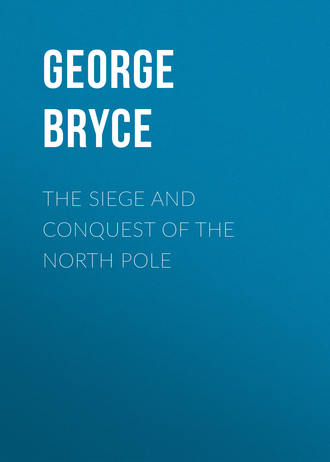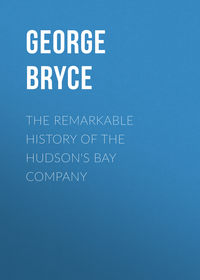 полная версия
полная версияThe Siege and Conquest of the North Pole
Soon after midnight of 22nd April, Dr. Cook and his two companions began their return journey. They set their course along the 100th meridian, and during the first few days, with fair weather and good ice, they succeeded in making long marches. On 30th April the latitude was found to be 88° 1′, and the longitude 97° 42′. As this showed a drift to the eastward, a more westerly course was set. The temperature still remained between 30° and 40° below zero, and the wind was again troublesome. Dr. Cook, with compass in hand, marched ahead of the sledges. Near the 88th parallel very heavy ice was crossed.
On the 6th May they were stopped by a very severe snowstorm. An attempt was made to build a snow-house, but the wind swept the blocks away. An effort was then made to put up the tent, but this was found impossible. In sheer despair, they crept under the tent without erecting the pole. For several days the wind was too strong to allow them to travel, and the atmospheric conditions made it impossible to take observations. Added to these difficulties was the fact that the food-supply was running short.
On 24th May the weather cleared sufficiently to enable Dr. Cook to make an observation, which placed them on the 84th parallel, near the 97th meridian.
The temperature now gradually rose to zero, and caused the formation of a fog which proved a serious obstacle to progress. It was Dr. Cook’s intention to make for his cache in Nansen’s Sound, but when next the sky cleared, after a long struggle, the party found themselves far south, in Crown-Prince Gustav Sea. Open water and broken ice made it impossible for them to reach Heiberg Island.
Dr. Cook was still anxious to return home in 1908, and when he saw that he was cut off from Annootok, he decided to make for Lancaster Sound, where he hoped to find one of the Scottish whalers. This allowed him to take advantage of the southerly drift of the ice. Passing through Hassel Sound, the party were fortunate in securing both bears and seals. Dr. Cook states that from this point they travelled southward over Norwegian Bay into Wellington Channel.3 Here, however, they found the ice so much broken up that sledging was impossible, and early in July they crossed the island of North Devon into Jones Sound. Open water was again met, and the party were forced to take to the folding canvas boat. As there was no food for the dogs, they were left behind to shift for themselves. One of the sledges had also to be left, and the other was taken to pieces and carried in the boat.
Now followed a long struggle, partly by boat and partly by sledge. Birds formed their chief food, and in securing these the last of the ammunition was expended. Baffin’s Bay was reached early in September, but it was found impossible to return to Greenland or to reach a place of safety farther south. The only alternative was to make a winter-hut and endeavour to secure sufficient food to carry them through till the following spring. They returned westwards to search for a suitable place to winter, and found it at Cape Sparbo, in Jones Sound. Here an underground hut was made of stones, bones, and turf; and by means of primitive weapons they succeeded in killing a sufficient number of animals to enable them to live through the winter, and to provide food and equipment for the return journey to Greenland.
On 18th February 1909 the winter quarters were left, and Annootok was reached on 15th April. Anxious to return home as speedily as possible, Dr. Cook set out for the Danish settlement at Upernavik, where he arrived on 21st May. From there he travelled to Copenhagen by Danish steamers.
This journey by Dr. Cook is unparalleled in the history of Arctic exploration. The bare idea of attempting to reach the North Pole, in one season, from the latitude of Annootok, was daring in the extreme. It is probably correct to say that no Arctic authority could expect that he would have the smallest chance of success. Many expeditions with much greater resources than Dr. Cook possessed had in the same region made the attempt from points hundreds of miles nearer the Pole, and had suffered utter defeat. Markham’s starting-point was about 240 geographical miles nearer the Pole, and his farthest north was 400 miles from the Pole. Lockwood’s base was over 200 miles nearer the Pole, and his record was only 4 miles farther than Markham’s. Dr. Cook was well aware that Commander Peary himself, by far the most experienced of Arctic explorers, had repeatedly made attempts from a base much nearer the Pole. Starting from Lockwood’s base in 1900, his farthest point reached was 370 miles from the Pole. A second attempt from the same point in 1902 reached a latitude 343 miles from the Pole. In 1906 his third trial was made from a ship situated more than 240 geographical miles nearer the Pole than Annootok, but the farthest north attained was still 174 miles from the Pole.
This was the position when Dr. Cook decided to make the attempt from Annootok. It is not surprising, therefore, that those acquainted with the history of the subject should find a serious difficulty in at once accepting Dr. Cook’s statement that he had accomplished such an extraordinary achievement.
His idea of avoiding the route through Kennedy Channel and adopting a course sufficiently west to escape the crushed-up land-ice was no doubt a good one, but making every allowance for this advantage, the contrast between his expedition and Commander Peary’s expedition of 1909 is very great. Commander Peary had relief parties to assist him until he was within 132 geographical miles of the Pole. His problem then was to travel these 132 miles and return to land 413 miles distant. Dr. Cook, on the other hand, was about 462 miles from the Pole when his last supporting party left him. To reach the Pole he had therefore to travel 462 miles against Peary’s 132, without being able to obtain any further supply of food. The return journey, again, was very different. Dr. Cook expected to find his cache 525 miles distant, but in reality the first land reached was more than 670 miles from the Pole. The total distance in latitude covered by Peary with the supply he was able to carry on his sledges was therefore 545 miles, whereas Cook states that he covered the extraordinary distance of 1132 miles.
Dr. Cook has still to satisfy experts, but no one will question the fact that Commander Peary has reached the North Pole; so that, no matter what the result of the unfortunate controversy may be, to the American nation belongs the great honour of winning the coveted prize.
During more than three centuries the record was held by the British. It was then captured by America in 1882. In 1895 it passed into the hands of the Norwegians, who held it until won by the Italians in 1900. America regained it in 1906, and now must keep it finally.
The chief records are as follows: —

1
These remarks were written before the discovery of Crocker Land and Bradley Land.
2
The discovery of Crocker Land and Bradley Land proves that this view was correct.
3
Dr. Cook seems to have made a mistake here. His route was evidently west of Norwegian Bay.


